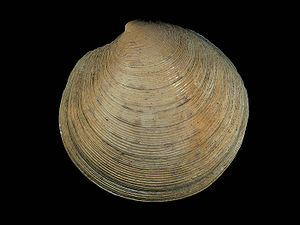Artemism shell
| Artemism shell | ||||||||||||
|---|---|---|---|---|---|---|---|---|---|---|---|---|

Artemism shell ( Dosinia exoleta (Linné, 1758)) |
||||||||||||
| Systematics | ||||||||||||
|
||||||||||||
| Scientific name | ||||||||||||
| Dosinia exoleta | ||||||||||||
| ( Linnaeus , 1758) |
The artemism clam ( Dosinia exoleta ) is a type of clam from the order of the Venerida .
features
The housing, which has the same flaps, is round in outline and measures around 6 cm in diameter. It is relatively flat and thick-skinned. It is slightly unequal, the vertebrae sit a little in front of the center line (based on the length of the case). The vertebra is bent forward. The anterior dorsal margin is concave, the posterior dorsal margin is convexly curved. The lunula is short but well developed with a radial back. The lock has three cardinal teeth in each of the two flaps, which are close to each other and engage in corresponding pits in the other flap. The left flap also has a posterior tooth, which corresponds to a pit on the right flap. The ligament extends about two-thirds of the length of the upper edge behind the vertebra. The area (“tag”) is hardly developed. The surface line is deeply indented, but the bay is relatively narrow. The siphons are quite long and grown together. There are two sphincters.
The color varies from light brownish white to yellow, sometimes with radial banding. The surface shows only fine concentric ribs and growth stripes. The periostracum is a thin, matt coating. The inner edge of the case is smooth.
Similar species
The artemism shell is more rounded in outline and also slightly larger than the smooth artemis ( Dosinia lupinus ). The surface of the Artemis Shell is matt, the surface of the Smooth Artemis, on the other hand, is glossy.
Geographical distribution, habitat and way of life
The distribution area of the artemism shell is the eastern Atlantic from Norway to West Africa . It also occurs in the North Sea .
The artemism shell lives completely buried in coarse-grained substrates. The eddy points upwards and the siphons therefore emerge at the rear end almost parallel to the sediment surface before they bend upwards and protrude into the open water. The animals live in shallow water down to a depth of about 100 m.
Taxonomy
The taxon was first published by Carl von Linné in 1758 as Venus exoleta . It is now generally accepted as belonging to the genus Dosinia Scopoli, 1777.
supporting documents
literature
- Fritz Gosselck, Alexander Darr, Jürgen HJ Jungbluth, Michael Zettler: common names for mollusks of the sea and brackish water in Germany. Mollusca, 27 (1): 3-32, 2009 PDF
- Fritz Nordsieck : The European sea shells (Bivalvia). From the Arctic Ocean to Cape Verde, the Mediterranean Sea and the Black Sea. 256 pages, Gustav Fischer Verlag, Stuttgart 1969
- Guido Poppe. Yoshihiro Goto: European Seashells Volume 2 (Scaphopoda, Bivalvia, Cephalopoda) . 221 pp., Verlag Christa Hemmen, Wiesbaden 1993 (2000 unc. Reprint), ISBN 3925919104 (p. 122)
- Rainer Willmann: Mussels of the North and Baltic Seas. 310 pp., Neumann-Neudamm, Melsungen 1989 ISBN 3-7888-0555-2 (pp. 136-138)
On-line
Individual evidence
- ^ Carl von Linné: Systema naturæ per regna tria naturæ, secundum classes, ordines, genera, species, cum characteribus, differentiis, synonymis, locis. Tomus I. Editio decima, reformata. 1-824, Stockholm / Holmia, Salvius, 1758 Online at www.biodiversitylibrary.org (p. 688)
- ↑ MolluscaBase: Dosinia exoleta (Linnaeus, 1758)